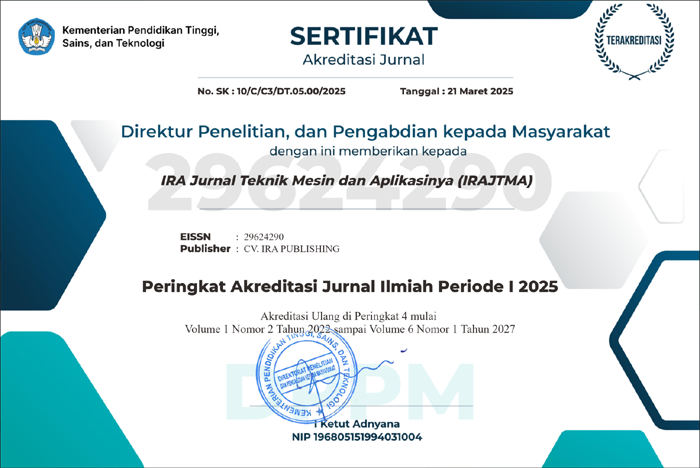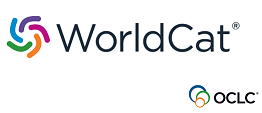Determination of Laser Cutting Process Parameters for the Surface Roughness of Acrylyc Materials
DOI:
https://doi.org/10.56862/irajtma.v2i2.43Keywords:
Acrylic, Laser cutting, Process parameters, Surface roughnessAbstract
Cutting materials using a laser beam is one of the modern methods in machining processes to cut complex geometries in two dimensions using a laser beam. Laser cutting can be used in cutting acrylic materials. However, there are obstacles to producing good surface conditions. The use of appropriate process parameters dramatically affects the resulting surface roughness. Therefore, it is necessary to research to determine the parameters of the laser cutting process that are suitable for the surface conditions of the workpiece, which has a small surface roughness value. Three variations of process parameters were used, namely cutting speeds of 6, 8, and 10 (mm/s), laser focus points of 4,6,8 (mm), and gas pressures of 90, 100, and 110 (mm/s). The specimens that have been cut then measured the surface roughness using a surface test measuring tool. The measurement data is then analyzed using the Taguchi method. The results showed that the highest roughness value was found in the second experiment with a roughness value of 1.015 µm, and the lowest was in the seventh experiment with a roughness value of 0.225. To produce a small roughness value, the process parameters used are gas pressure 100 mm/s, cutting speed eight mm/s and focal point 8 mm/s, and the most dominant influence factor is the gas pressure parameter with a value of 7.494.
References
Arifin, Z. 2018. “Pengaruh variasi cutting speed terhadap kekasaran permukaan SUS 304 pada proses laser cutting menggunakan gas N2.” Universitas Brawijaya, Malang.
Chryssolouris, G. 2013. Laser machining: theory and practice. Springer Science & Business Media.
Hadimi, H. 2008. “Pengaruh Perubahan Kecepatan Pemakanan Terhadap Kekasaran Permukaan Pada Proses Pembubutan.” Semesta Teknika 11(1): 18-28.
Lubis, M. S. Y., Siahaan, E., Darmawan, S., Adianto, A., dan Ronald, R. 2019. “Variation Of Cutting Parameters in The Process of Turning AISI 4340 Steel On Surface Roughness.” Sinergi 23(2): 139-144.
Lubis, Muhammad Sobron Yamin, Steven D, Alfred Briantio, and Rosehan Rosehan. 2023. “Penentuan Parameter Pemotongan Optimal Proses Milling Terhadap Kekasaran Permukaan Baja SKD11 Dengan Metode Taguchi.” IRA Jurnal Teknik Mesin Dan Aplikasinya (IRAJTMA) 1 (3): 44–50. https://doi.org/10.56862/irajtma.v1i3.33.
Munadi, S. 1988. Dasar-Dasar Metrologi Industri. Jakarta: Proyek Pengembangan Lembaga Pendidikan Tenaga Kependidikan.
Noor, M. M., Kadirgama, K., & Rahman, M. M. 2010. “Analysis Of Surface Roughness For Laser Cutting On Acrylic Sheets Using Response Surface Method.” In National Conference in Mechanical Engineering Research and Postgraduate Students.
Nugroho, A., Hutama, A. S., dan Budiyantoro, C. 2018. “Optimasi keakuratan dimensi dan kekasaran permukaan potong material akrilik dengan proses laser menggunakan metode Taguchi dan PCR-TOPSIS.” JMPM (Jurnal Material dan Proses Manufaktur) 2(2): 75-82.
Purwanti, E. P., & Pilarian, F. 2013. “Optimasi Parameter Proses Pemotongan Stainless Steel SUS 304 Untuk Kekasaran Permukaan Dengan Metode Response Surface.” In Prosiding Seminar Nasional Matematika dan Pendidikan Matematika FMIPA UNY. Vol. 978.
Rakasita, R., Karuniawan, B. W., dan Juniani, A. I. 2016. “Optimasi Parameter Mesin Laser Cutting Terhadap Kekasaran Dan Laju Pemotongan Pada Sus 316l Menggunakan Taguchi Grey Relational Analysis Method.” Jurnal Teknik Industri 11(2): 97-106.
Shivapragash, B., Chandrasekaran, K., Parthasarathy, C., & Samuel, M. 2013. “Multiple Response Optimizations In Drilling Using Taguchi And Grey Relational Analysis.” International Journal of Modern Engineering Research 3(2): 765-768.
Stournaras, A., Stavropoulos, P., Salonitis, K., dan Chryssolouris, G. 2009. “An investigation of quality in CO2 laser cutting of aluminum.” CIRP Journal of Manufacturing Science and Technology 2(1): 61-69.
Tönshoff, H. K., dan Emmelmann, C. 1989. “Laser cutting of advanced ceramics.” CIRP Annals 38(1): 219-222.
Downloads
Published
How to Cite
Issue
Section
License
Copyright (c) 2023 IRA Jurnal Teknik Mesin dan Aplikasinya (IRAJTMA)

This work is licensed under a Creative Commons Attribution-ShareAlike 4.0 International License.

















